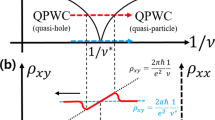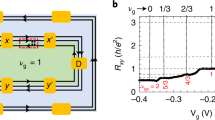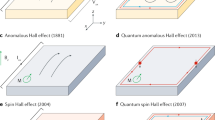Abstract
The quantum Hall effect arises from the interplay between localized and extended states that form when electrons, confined to two dimensions, are subject to a perpendicular magnetic field1. The effect involves exact quantization of all the electronic transport properties owing to particle localization. In the conventional theory of the quantum Hall effect, strong-field localization is associated with a single-particle drift motion of electrons along contours of constant disorder potential2. Transport experiments that probe the extended states in the transition regions between quantum Hall phases have been used to test both the theory and its implications for quantum Hall phase transitions. Although several experiments3,4,5,6,7,8,9 on highly disordered samples have affirmed the validity of the single-particle picture, other experiments10,11,12 and some recent theories13,14,15 have found deviations from the predicted universal behaviour. Here we use a scanning single-electron transistor to probe the individual localized states, which we find to be strikingly different from the predictions of single-particle theory. The states are mainly determined by Coulomb interactions, and appear only when quantization of kinetic energy limits the screening ability of electrons. We conclude that the quantum Hall effect has a greater diversity of regimes and phase transitions than predicted by the single-particle framework. Our experiments suggest a unified picture of localization in which the single-particle model is valid only in the limit of strong disorder.
This is a preview of subscription content, access via your institution
Access options
Subscribe to this journal
Receive 51 print issues and online access
$199.00 per year
only $3.90 per issue
Buy this article
- Purchase on Springer Link
- Instant access to full article PDF
Prices may be subject to local taxes which are calculated during checkout




Similar content being viewed by others
References
Prange, R. E. & Girvin, S. M. The Quantum Hall Effect (Springer, New York, 1990)
Huckestein, B. Scaling theory of the integer quantum Hall-effect. Rev. Mod. Phys. 67, 357–396 (1995)
Wei, H., Tsui, D., Paalanen, M. & Pruisken, A. Experiments on delocalization and universality in the integral quantum Hall effect. Phys. Rev. Lett. 61, 1294–1296 (1988)
Wei, H. P., Lin, S. Y., Tsui, D. C. & Pruisken, A. M. M. Effect of long-range potential fluctuations on scaling in the integer quantum Hall-effect. Phys. Rev. B 45, 3926–3928 (1992)
Engel, L., Wei, H. P., Tsui, D. C. & Shayegan, M. Critical exponent in the fractional quantum Hall-effect. Surf. Sci. 229, 13–15 (1990)
Koch, S., Haug, R., von-Klitzing, K. & Ploog, K. Size-dependent analysis of the metal-insulator transition in the integral quantum Hall effect. Phys. Rev. Lett. 67, 883–886 (1991)
Engel, L. W., Shahar, D., Kurdak, C. & Tsui, D. C. Microwave frequency-dependence of integer quantum Hall-effect—evidence for finite-frequency scaling. Phys. Rev. Lett. 71, 2638–2641 (1993)
Hohls, F., Zeitler, U. & Haug, R. Hopping conductivity in the quantum Hall effect: Revival of universal scaling. Phys. Rev. Lett. 88, 1–4 (2002)
Hohls, F. et al. Dynamical scaling of the quantum Hall plateau transition. Phys. Rev. Lett. 89, 1–4 (2002)
Shahar, D. et al. A new transport regime in the quantum Hall effect. Solid State Commun. 107, 19–23 (1998)
Balaban, N., Meirav, U. & Bar-Joseph, I. Absence of scaling in the integer quantum Hall effect. Phys. Rev. Lett. 81, 4967–4970 (1998)
Cobden, D. H., Barnes, C. H. W. & Ford, C. J. B. Fluctuations and evidence for charging in the quantum Hall effect. Phys. Rev. Lett. 82, 4695–4698 (1999)
Chklovskii, D. B. & Lee, P. A. Transport properties between quantum Hall plateaus. Phys. Rev. B 48, 18060–18078 (1993)
Cooper, N. R. & Chalker, J. T. Coulomb interactions and the integer quantum Hall-effect—screening and transport. Phys. Rev. B 48, 4530–4544 (1993)
Ruzin, I., Cooper, N. & Halperin, B. Nonuniversal behavior of finite quantum Hall systems as a result of weak macroscopic inhomogeneities. Phys. Rev. B 53, 1558–1572 (1996)
Ilani, S., Yacoby, A., Mahalu, D. & Shtrikman, H. Unexpected behavior of the local compressibility near the B = 0 metal-insulator transition. Phys. Rev. Lett. 84, 3133–3136 (2000)
Yoo, M. J. et al. Scanning single-electron transistor microscopy: Imaging individual charges. Science 276, 579–582 (1997)
Yacoby, A., Hess, H. F., Fulton, T. A., Pfeiffer, L. N. & West, K. W. Electrical imaging of the quantum Hall state. Solid State Commun. 111, 1–13 (1999)
Zhitenev, N. B. et al. Imaging of localized electronic states in the quantum Hall regime. Nature 404, 473–476 (2000)
Ilani, S., Yacoby, A., Mahalu, D. & Shtrikman, H. Microscopic structure of the metal-insulator transition in two dimensions. Science 292, 1354–1357 (2001)
Efros, A. L. & Ioffe, A. F. Nonlinear screening and the background density of 2DEG states in magnetic field. Solid State Commun. 67, 1019–1022 (1988)
Efros, A. L., Pikus, F. G. & Burnett, V. G. Density of states of a two-dimensional electron gas in a long-range random potential. Phys. Rev. B 47, 2233–2243 (1993)
Shashkin, A. et al. Percolation metal-insulator transitions in the two-dimensional electron system of AlGaAs/GaAs heterostructures. Phys. Rev. Lett. 73, 3141–3144 (1994)
Kukushkin, I., Fal'ko, V., Haug, R., von Klitzing, K. & Eberl, K. Magneto-optical evidence of the percolation nature of the metal-insulator transition in the two-dimensional electron system. Phys. Rev. B 53, R13260–R13263 (1996)
Acknowledgements
We benefited from discussions with A. M. Fink'elstein, Y. Gefen, Y. Meir, A. Stern and N. B. Zhitenev. This work was supported by the Israeli Science Foundation and the German MINERVA foundation.
Author information
Authors and Affiliations
Corresponding author
Ethics declarations
Competing interests
The authors declare that they have no competing financial interests.
Rights and permissions
About this article
Cite this article
Ilani, S., Martin, J., Teitelbaum, E. et al. The microscopic nature of localization in the quantum Hall effect. Nature 427, 328–332 (2004). https://doi.org/10.1038/nature02230
Received:
Accepted:
Issue Date:
DOI: https://doi.org/10.1038/nature02230
This article is cited by
-
Microwave impedance microscopy and its application to quantum materials
Nature Reviews Physics (2021)
-
Quantum-dot assisted spectroscopy of degeneracy-lifted Landau levels in graphene
Nature Communications (2020)
-
Simultaneous voltage and current density imaging of flowing electrons in two dimensions
Nature Nanotechnology (2019)
-
Conductance quantization suppression in the quantum Hall regime
Nature Communications (2018)
-
The local nature of incompressibility of quantum Hall effect
Nature Communications (2017)
Comments
By submitting a comment you agree to abide by our Terms and Community Guidelines. If you find something abusive or that does not comply with our terms or guidelines please flag it as inappropriate.



